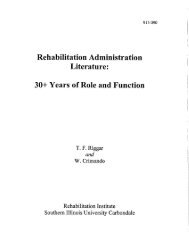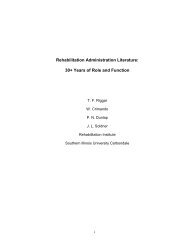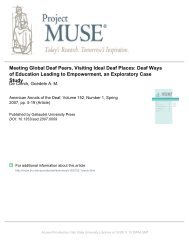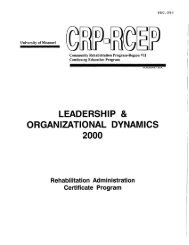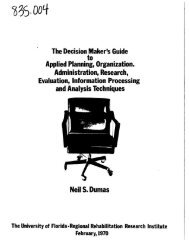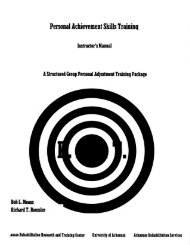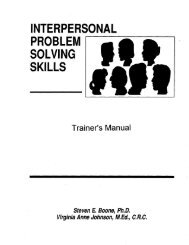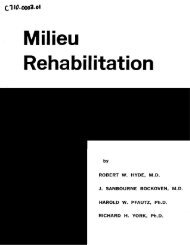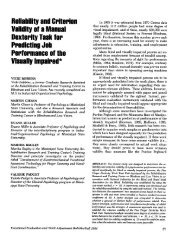by requirements for the degree of (Education) - NCRTM
by requirements for the degree of (Education) - NCRTM
by requirements for the degree of (Education) - NCRTM
Create successful ePaper yourself
Turn your PDF publications into a flip-book with our unique Google optimized e-Paper software.
Rehabilitated<br />
Closures--Not<br />
XIX-XXVII)<br />
(Tables<br />
Of <strong>the</strong> total number <strong>of</strong> closures (974), 156 (16%) were closed not .re-<br />
habilitated, <strong>of</strong> whom 144 (92%) were closed prior to acceptance (status 08)<br />
and 12 (eight per cent) were closed after acceptance (status 28 or 30) but<br />
prior to completion <strong>of</strong> <strong>the</strong> vocational plan (Table XXI). The statewide per-<br />
centages <strong>of</strong> people closed not rehabilitated as compared with rehabilitated<br />
were quite consistent from one year to <strong>the</strong> next. The fact that <strong>the</strong> majority<br />
<strong>of</strong> DVR closures were rehabilitated closures is one measure <strong>of</strong> <strong>the</strong> success<br />
<strong>of</strong> <strong>the</strong> agency's involvement with <strong>the</strong> population studied. However, <strong>the</strong>re is<br />
need <strong>for</strong> more comprehensive in<strong>for</strong>mation concerning <strong>the</strong> quality <strong>of</strong> <strong>the</strong>se<br />
closures in terms <strong>of</strong> permanency and whe<strong>the</strong>r or not <strong>the</strong> type <strong>of</strong> work, earn-<br />
ings and opportunities <strong>for</strong> bettering oneself are commensurate with <strong>the</strong><br />
individual's abilities and interests.<br />
Examining <strong>the</strong> 144 clients not accepted <strong>for</strong> services, status 08, it<br />
is noted that 72% (103) were identified as mildly retarded, six per cent<br />
(8) as moderately retarded and one per cent (i) as severely retarded; <strong>for</strong><br />
32 clients (21%) <strong>the</strong> exact level <strong>of</strong> retardation was not known at <strong>the</strong> time<br />
<strong>of</strong> closure (Table XXIV). These figures seem to indicate that <strong>the</strong>re was<br />
not a disproportionate number <strong>of</strong> moderately and severely retarded among<br />
<strong>the</strong> people declared not eligible <strong>for</strong> services. The following is a break-<br />
down <strong>of</strong> <strong>the</strong> reasons given <strong>for</strong> not accepting <strong>the</strong>se people <strong>for</strong> services:<br />
a) 56% (80) <strong>of</strong> <strong>the</strong> people refused services, b) 13% (19) were unable to<br />
be contacted, moved, or died, c) seven per cent (i0) had no vocational<br />
handicap, d) five per cent (7) had no disabling condition, e) <strong>for</strong> three<br />
per cent (5) <strong>the</strong> handicap was too severe, and f) 16% (23) were closed <strong>for</strong><br />
o<strong>the</strong>r reasons. It would be particularly interesting to do a follow-up<br />
54




